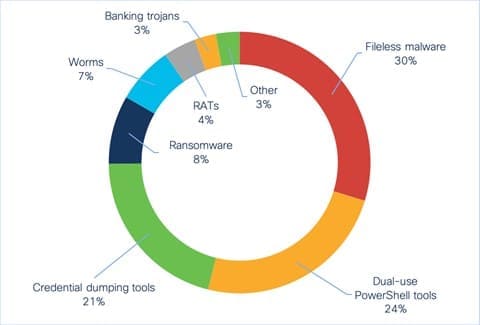
What Is Cybersecurity Awareness? Why Do You Need It?
Jan 23, 2021
2020 was a year littered with unforeseen circumstances. Often, these turn of events were deemed too much of a storm for even the greatest of organizations across the globe.
In order to promote perpetual productivity, businesses were coerced to switch to remote working. With this new and vulnerable working model, hackers have been relentlessly attacking unsuspecting employees with a range of bombshells. During the COVID-19 pandemic, cyberattacks have skyrocketed up to 600%. Hackers have been rather successful on this part simply by deception or, in other words, well-crafted phishing emails. They have successfully posed as prominent members of the Centers for Disease Control and Prevention (CDC) or World Health Organization (WHO) on countless emails, luring myriads of victims. However, such catastrophes have always existed, and the issue has only been magnified through the eyes of the pandemic, substantially amplifying the dire need for a robust cybersecurity awareness training program in enterprises to shield our post-pandemic networks against cybercrime.
Cybersecurity Awareness and Its Significance
The enforcement of cybersecurity awareness training in organizations will not only promote enterprise-wide knowledge of cyberattacks, it also contributes to halting cyber criminals in their tracks globally.
Comprehensive training will assist organizations in strengthening their cybersecurity posture. It equips employees with the skills and knowledge needed to understand what cyber risks are, their impact on the business, how to detect cyberattacks, and the best ways to avoid such risks.
These programs not only fortify your defenses but pave the way to a more GDPR-compliant status.
3 Best Methods to Deliver Cybersecurity Awareness Training
Successful educational platforms are driven to deliver impactful content. Here are 3 elements that could potentially revamp your organization’s cybersecurity awareness training program for an amplified security impact.
1. Basic to advanced video sessions
It is a cardinal right of any individual to receive training that interests them and keeps them on their toes. Traditional classroom training simply does not make the cut and has a low probability of effectiveness.
Visually enriched training provide employees with the intensity of being in the situations described rather than reading about the situations. This allows them to absorb all the details efficiently and apply the lessons learnt in everyday life. These programs are considered to be highly scalable and more cost-effective than the traditional cybersecurity training method. It also allows learners to learn on the go, giving them the liberty to learn from anywhere and anytime.
2. “Customizable” interactive applications
Interactivities are essential for memory retention and it tests a learner’s knowledge from material. One can only succeed in said interactivities if they have understood the basics of the materials provided. This, in turn, will allow them to be more confident and master the appropriate responses to a cyberattack. The best way to develop interactive applications is by incorporating quizzes into the program. You can add them at the end of each training module or after the entire CyberSec training program.
3. Gamification
Gamification is often viewed as “immature” and only meant for a younger crowd. But there is a reason why the brightest of individuals also happen to be people who interact with games that challenges their methodologies in executing a thought. Gamification in security awareness training can be thrilling, eye-catching, groundbreaking, and most essentially, life-changing. Games have the capability to teach real-life situations much better than classroom learning, hence, contributing to a long-lasting experience to your employees.
4 Common Cyberattacks to Include in Your Cybersecurity Awareness Training
Now, you have come upon a ruling of how a security awareness training program can be executed or implemented. However, it is regulatory to include the most common cyberattacks to educate and prepare employees for the next possible malware to take down your organization. Your cybersecurity awareness program should address contemporary security challenges with the common forms of cyberattacks that can result in destruction. Your staff must be trained to identify the following security threats:
1. Phishing Attacks
Verizon’s 2020 Data Breach Investigations Report (DBIR) states that over 30% of SMBs face phishing attacks followed by stolen credentials and password dumpers. Phishing is the most common cyberattack that plays with the psychology of your staff. Being a social engineering method, it triggers emotions that make your employees behave as per the attacker’s intent. Phishing scams are generally followed by malware, ransomware, and other types of deadly attacks.
Phishing attacks lure your employees into clicking on spam links, downloading unsafe attachments, and visiting malicious websites These activities then give black hat hackers a gateway to breach secure networks and extract sensitive data.
2. Malware Attacks
Despite having a detailed cybersecurity strategy, 28% of SMBs were visited by unexpected malware, causing additional expenses.
Malware attacks are a subset of email phishing, where malicious hackers weaponize email attachments as malware carriers. Upon downloading, these infected attachments could lead to a security breach of servers, networks, or systems. This can lead to irreversible damage for the targeted entities.
3. Fileless Attacks

Source: Cisco
Fileless malware attacks were considered to be the most common critical-severity cybersecurity threat in the first half of 2020. This attack targets frequently utilized software or applications with no regular updates.
Fileless attacks are more likely to succeed than traditional ones as they are difficult to detect.
4. Human Error
According to the UK Information Commissioner’s Office’s 2019 report, 90% of data breaches were a result of human error. These measly errors could result in catastrophes such as loss of potential clients and customers, and a damaged reputation.
How Can You Avoid Disastrous Unforeseen Cybersecurity Events with Effective Cybersecurity Awareness Training?
Cyberattacks are inevitable, but preventable. Black hat hackers have the skills and resources to exploit vulnerabilities and penetrate secured systems. The only way around this security challenge is to strengthen the weakest link first. Start with educating your employees, especially remote workers. Suppose your staff is not informed enough to distinguish between malicious and genuine attachments, or which network to connect to. In such a case, your organization qualifies as the potential target of a security breach. Build a risk-aware workspace for a more secure tomorrow by enforcing cybersecurity awareness trainings.
Before you leave, watch this comprehensive coverage on security awareness training by Aaron Birnbaum, an experienced technology professional with more than 30 years of experience:
FAQs
A. Cyber safety awareness is the knowledge that depicts an end user’s awareness about common cyber risks and threats.
Read more: Why Do You Need Security Training for Your Employees?
A. Enterprises can improve its cybersecurity awareness by introducing a formal CyberSec training program. They can also test their employees with simulated cyberattacks.
Read more: Is Security Awareness Vital for Your Organization?
A. The best way to deliver security awareness is by building a program that includes engaging visuals, interactive presentations, strategic mock exams, and insightful gamification.
Read more: How to Keep Your Business Safe from Cyberattacks?